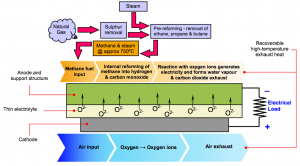. . . as our friends at Hungry Beast say. But hey, nobody does a launch of an 18 year old technology like the yanks. A former NASA scientist (to make it sound more sexy, no doubt) has brought us the trendily named Bloom Box, claiming it to be the big thing after ten years of development. Ah, unfortunately, not.
Oh, he has got a planar design, solid oxide fuel cell in those fridge size boxes, to be sure. The problem is, they aren’t new, having been first begun commercialisation in 1992 by companies such as Ceramic Fuel Cells Limited here in Australia, or UTC in America. These companies actually sell now what this bloke is saying you can have soon for $800k and hopefully for $3000 in a few years. Hell, the Australian company had their piece of kit doing demo work on top of the old office I had in the technology park back in 2000.
I don’t know exactly what CFCL sells their piece of kit at, and to my knowledge they are still only selling them to small companies, with a consumer product to be available “sometime in 2010”. My guess is that CFCL would probably offer their unit at a cost a bit less than what Bloom is saying for a similar sized application for small businesses. The big difference is that if you call CFCL or UTC, they actually have something to install when they take your money.
In my opinion, Bloom’s entrepreneur is most likely a hype merchant so insignificant I won’t even look up his name. My suspicions were raised when I first heard his release where he says he has some “proprietary software” that is the key to his Bloom Box. Uh huh, and mine has magic beans.
According to reputable news agencies on science and technology (National Geographic News), based on the information the company has made public, the Bloom Box technology is not revolutionary. They quote Friedrich Prinz, a fuel cell expert at Stanford University, the design of the Bloom Box appears to be fairly standard and that there was nothing obviously revolutionary about it. “They didn’t reveal any new physics or any new principles, but I don’t think they need to do that,” he said.
Note the end of the professor’s statement. What he means by “they don’t need to do that” is that solid oxide fuel cell technology is exciting and very interesting. It’s essentially “burning” something, but not in the physical sense, more in the chemical sense, through a reactor that can be coated onto thin plates. It’s basically a chemical engineer’s wet dream, so I will go on, or you can do your own research elsewhere. The heart of the fuel cell is a high rate chemical battery that produces the electricity

You feed it the same type of stuff you feed an internal combustion engine (methane and air) and it produces electricity (only in DC form as opposed to AC) and it also produces waste heat you can recover at high temperature for other use (like heating water for your house). But the cost of the fuel cell to manufacture is pretty high, because the methane you use to feed it is just a good source of what you really want to feed it – hydrogen. So you basically have to put a miniature stripper and reformer on the front of the rig. Plus, coating the anodes and cathodes of the reactor and getting them spaced out exactly as you require is expensive assembly work.
However, the real current manufacturers (CFCL and UTC) of solid oxide fuel cells do intend to get their equipment down in cost for home application in the next year. And then let them work the kinks out of the technology at their demonstration plants and then we will see whether I will be buying one for my back yard.
But you know, probably I will anyway just to mess around with it. Either that, or I am starting the home nuclear reactor this year. Besides, all the cool kids will have one. I thought so enough at the depth of the financial crisis that I started buying stock in the company. There’s your free stock tip for the day, for those tuning in that made it this far.